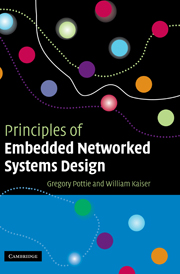Book contents
- Frontmatter
- Contents
- Preface
- Acknowledgments
- List of Abbreviations
- 1 Embedded network systems
- 2 Representation of signals
- 3 Signal propagation
- 4 Sensor principles
- 5 Source detection and identification
- 6 Digital communications
- 7 Multiple source estimation and multiple access communications
- 8 Networking
- 9 Network position and synchronization services
- 10 Energy management
- 11 Data management
- 12 Articulation, mobility, and infrastructure
- 13 Node architecture
- 14 Network data integrity
- 15 Experimental systems design
- 16 Ethical, legal, and social implications of ENS
- 17 Design principles for ENS
- Appendix A Gaussian Q function
- Appendix B Optimization
- Index
1 - Embedded network systems
Published online by Cambridge University Press: 10 August 2009
- Frontmatter
- Contents
- Preface
- Acknowledgments
- List of Abbreviations
- 1 Embedded network systems
- 2 Representation of signals
- 3 Signal propagation
- 4 Sensor principles
- 5 Source detection and identification
- 6 Digital communications
- 7 Multiple source estimation and multiple access communications
- 8 Networking
- 9 Network position and synchronization services
- 10 Energy management
- 11 Data management
- 12 Articulation, mobility, and infrastructure
- 13 Node architecture
- 14 Network data integrity
- 15 Experimental systems design
- 16 Ethical, legal, and social implications of ENS
- 17 Design principles for ENS
- Appendix A Gaussian Q function
- Appendix B Optimization
- Index
Summary
Introduction
Continuing advances in integrated circuit technology have enabled the integration of computation and communication capabilities into devices which monitor or control physical processes. Digital controllers and sensors are found in automobiles, home appliances, factories, aircraft, cellular telephones, video games, and environmental monitoring systems. Indeed, the vast majority of processors now being manufactured are used in embedded applications (i.e., having connection to physical processes) rather than in what would ordinarily be thought of as a computer. Many are networked within the confines of a local control system, typically in master/slave configurations. However, advances in wireless technology and in the understanding of distributed systems are now making possible far more elaborate compositions of embedded systems that may function as the connection of the Internet to the physical world. Embedded network systems (ENS) are poised to become pervasive in the environment with the potential for far-reaching societal changes that have hitherto been the subject of science fiction. It is the purpose of this book to lay out the foundations of this technology, the emerging design principles and applications, and some of the interesting societal questions raised by ENS. This chapter provides some examples of ENS, discusses relevant technological trends, explores some implications of scaling to very large numbers of ENS nodes, and places the technology in a historical context.
- Type
- Chapter
- Information
- Principles of Embedded Networked Systems Design , pp. 1 - 11Publisher: Cambridge University PressPrint publication year: 2005



